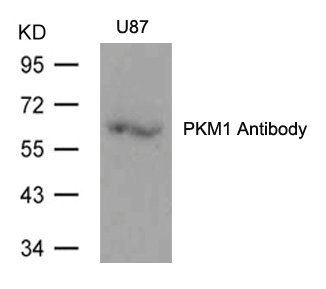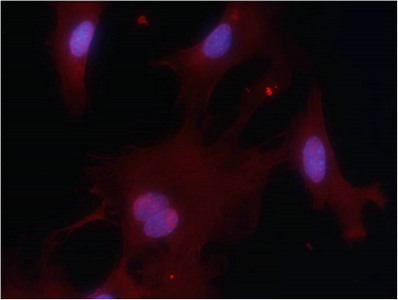
Western blot analysis of extracts from U87 cells using PKM1 Antibody.
PKM Antibody
CSB-PA143103
ApplicationsImmunoFluorescence, Western Blot, ELISA
Product group Antibodies
ReactivityHuman, Mouse
TargetPKM
Overview
- SupplierCusabio
- Product NamePKM Antibody
- Delivery Days Customer20
- ApplicationsImmunoFluorescence, Western Blot, ELISA
- CertificationResearch Use Only
- ClonalityPolyclonal
- ConjugateUnconjugated
- Gene ID5315
- Target namePKM
- Target descriptionpyruvate kinase M1/2
- Target synonymsCTHBP; cytosolic thyroid hormone-binding protein; epididymis secretory protein Li 30; HEL-S-30; OIP3; OPA-interacting protein 3; p58; PK, muscle type; PK3; PKM2; pyruvate kinase 2/3; pyruvate kinase isozymes M1/M2; pyruvate kinase muscle isozyme; pyruvate kinase PKM; pyruvate kinase, muscle; TCB; THBP1; thyroid hormone-binding protein 1; thyroid hormone-binding protein, cytosolic; tumor M2-PK
- HostRabbit
- IsotypeIgG
- Protein IDP14618
- Protein NamePyruvate kinase PKM
- Scientific DescriptionGlycolytic enzyme that catalyzes the transfer of a phosphoryl group from phosphoenolpyruvate (PEP) to ADP, generating ATP. Stimulates POU5F1-mediated transcriptional activation. Plays a general role in caspase independent cell death of tumor cells. The ratio betwween the highly active tetrameric form and nearly inactive dimeric form determines whether glucose carbons are channeled to biosynthetic processes or used for glycolytic ATP production. The transition between the 2 forms contributes to the control of glycolysis and is important for tumor cell proliferation and survival. Christofk, H.R. et al. (2008) Nature 452, 230-3. Mazurek, S. et al. (2005) Semin Cancer Biol 15, 300-8. Dombrauckas, J.D. et al. (2005) Biochemistry 44, 9417-29. Hitosugi, T. et al. (2009) Sci Signal 2, ra73.
- ReactivityHuman, Mouse
- Storage Instruction-20°C or -80°C
- UNSPSC12352203

